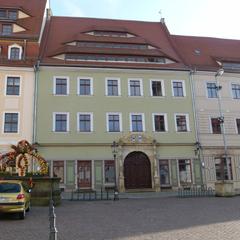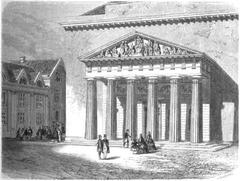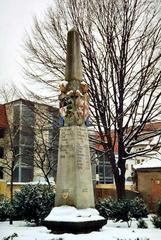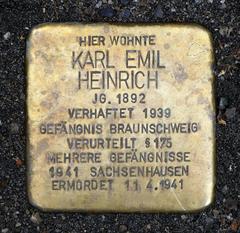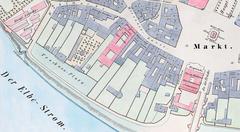Comprehensive Guide to Visiting Elberadweg, Pirna, Germany
Date: 01/08/2024
Introduction
Pirna, often referred to as the ‘Gateway to Saxon Switzerland,’ is a mesmerizing town steeped in history and culture, making it a significant point of interest for travelers exploring Germany. This guide provides a comprehensive overview of the Elberadweg, a notable cycling route that traverses through Pirna, highlighting its historical significance, practical visitor information, and travel tips. Established officially in 1233, Pirna’s roots extend back to the Stone Age, reflecting a rich medieval heritage evident in its architecture and urban layout. Landmarks such as the St. Marien Church, with its impressive late Gothic architecture and ceiling paintings from the Reformation era, stand testament to the town’s historical importance (MyGermanCity; Elbe Cycle Route).
The Elberadweg, or Elbe Cycle Path, stretches approximately 1,270 kilometers from the Czech Sudeten Mountains to Cuxhaven in Germany, with Pirna serving as a crucial starting point for the popular segment through Saxony. This guide also delves into visitor information such as ticket prices and opening hours for various historical sites along the route, ensuring a well-rounded and informed visit. In addition, we explore nearby attractions like the Saxon Switzerland National Park and the city of Dresden, enriching the overall travel experience (Komoot).
Table of Contents
- Introduction
- Historical Significance of Elberadweg, Pirna, Germany
- Visitor Information
- Travel Tips and Nearby Attractions
- Special Events and Guided Tours
- Photographic Spots
- Historical Landmarks Along the Route
- The Impact of the Elbe River
- Historical Events and Figures
- The Influence of Martin Luther
- Preservation and Modernization
- FAQ
- Conclusion
Historical Significance of Elberadweg, Pirna, Germany
Medieval Origins and Development
Pirna’s rich history dates back to the Stone Age, and the town was officially established in 1233. Its medieval roots are evident in its architecture and urban layout. The Marketplace in Pirna, with its cobbled streets and ornate buildings, transports visitors back to a bygone era (MyGermanCity).
Architectural Heritage
One of the most significant historical landmarks in Pirna is the St. Marien Church. Constructed between 1502 and 1546, this late Gothic church is renowned for its impressive roof structure, the largest church roof in Saxony. The church’s tower stands at 60 meters, and its self-supporting roof does not rest on the ceiling vault below, making it an architectural marvel of its time. The church also features figural ceiling paintings from the Reformation era, dating from 1544 to 1546 (Elbe Cycle Route).
The Role of Pirna in the Elberadweg
The Elberadweg, or Elbe Cycle Path, stretches approximately 1,270 kilometers from the Czech Sudeten Mountains to Cuxhaven in Germany. Pirna serves as a crucial starting point for the 180-kilometer stretch through Saxony, the most popular segment of the route. This section is known for its flat, paved paths that make it accessible to cyclists of all levels, including families and beginners (Komoot).
Visitor Information
Ticket Prices
Access to the Elberadweg is generally free, but certain historical sites and museums along the route may require tickets. For instance, entry to the St. Marien Church and the Stadtmuseum in Pirna may have associated costs. It’s advisable to check the respective websites for the most current ticket prices.
Opening Hours
Most historical sites and museums in Pirna and along the Elberadweg follow standard opening hours, typically from 10 AM to 6 PM. However, hours may vary seasonally, so it’s best to consult individual locations for accurate timings.
Accessibility
The Elberadweg is designed to be accessible to cyclists of all levels, including families with children and beginners. The paths are well-paved and flat, making them suitable for all types of bicycles.
Travel Tips and Nearby Attractions
When visiting Pirna and the Elberadweg, consider exploring nearby attractions such as the Saxon Switzerland National Park and the city of Dresden. These locations offer additional cultural and natural experiences that complement your visit.
Special Events and Guided Tours
Guided tours and special events are frequently organized along the Elberadweg, providing deeper insights into the region’s history and culture. Check local tourism websites for upcoming events and tour schedules.
Photographic Spots
The Elberadweg offers numerous picturesque spots for photography, including the iconic Blue Bridge in Dresden and the scenic landscapes of the Elbe River. Capture the medieval charm of Pirna’s Marketplace and the architectural beauty of St. Marien Church.
Historical Landmarks Along the Route
Dresden
Dresden is famous for its Baroque architecture and the iconic Blue Bridge. The city’s rich history and cultural heritage make it a must-visit along the Elberadweg.
Meissen
Meissen is known for its porcelain and wine heritage, dating back over a thousand years. The town’s historical significance adds an extra layer of interest to your journey.
The Impact of the Elbe River
The Elbe River has played a crucial role in the development and history of the regions it flows through. In Pirna, the river facilitated trade and transportation, contributing to the town’s growth and prosperity. The Elbe River Biosphere Reserve, a UNESCO-protected area, highlights the river’s ecological and cultural significance. This reserve is a testament to the harmonious coexistence of human activity and natural preservation along the Elbe (Komoot).
Historical Events and Figures
Pirna and the surrounding regions have been witness to numerous historical events and figures. The town’s Dominican monastery, dating back to the 13th century, now houses the Municipal Museum, which showcases religious artifacts and art. The Stadtmuseum offers a comprehensive historical exhibition of Pirna, while the Richard Wagner Graupa museum caters to those interested in the composer’s life and works (MyGermanCity).
The Influence of Martin Luther
The Elberadweg also passes through Wittenberg, the city of Martin Luther, where the Protestant Reformation began. This historical connection adds a layer of cultural and religious significance to the route, attracting visitors interested in exploring the roots of Protestantism. The Lutherstadt Wittenberg offers various cultural highlights, city tours, and activities related to Martin Luther’s legacy (Elbe Cycle Route).
Preservation and Modernization
Efforts to preserve the historical and cultural heritage of Pirna and the Elberadweg are evident in the well-maintained architecture and the development of cycle-friendly infrastructure. The route is exclusively for cyclists, well-signposted, and serviced with numerous accommodations and rest areas tailored to the needs of cyclists. This blend of preservation and modernization ensures that the historical significance of the region is accessible to contemporary visitors (Komoot).
FAQ
Q: What are the best times to visit the Elberadweg? A: The best times to visit are during the spring and summer months when the weather is pleasant for cycling and sightseeing.
Q: Are there guided tours available? A: Yes, guided tours are available and can be booked through local tourism offices or online.
Q: Is the Elberadweg suitable for beginner cyclists? A: Absolutely, the route is well-paved and flat, making it accessible to cyclists of all levels.
Conclusion
Exploring the Elberadweg in Pirna, Germany, offers a unique blend of historical, cultural, and natural experiences. From the medieval charm of Pirna’s architecture to the scenic vistas along the Elbe River, this cycling route is a journey through time and nature. Key landmarks such as the St. Marien Church and the bustling Marketplace provide glimpses into Pirna’s rich past, while the well-paved paths of the Elberadweg make it accessible for cyclists of all levels. The route’s connection to significant historical events and figures, including the influence of Martin Luther and the Protestant Reformation, adds layers of cultural depth for visitors (Elbe Cycle Route; MyGermanCity).
Beyond the historical aspects, the Elberadweg’s preservation and modernization efforts ensure that it remains a vibrant and accessible destination for contemporary travelers. Visitors can enjoy a range of accommodations, dining options, and nearby attractions such as the Saxon Switzerland National Park and Dresden, enhancing their overall experience. By following the travel tips and guidelines provided, visitors can ensure a safe, enjoyable, and memorable trip along this picturesque cycling route. Stay connected with the latest updates and travel tips by downloading the Audiala mobile app and following us on social media.
References
- MyGermanCity. (n.d.). Pirna. MyGermanCity
- Elbe Cycle Route. (n.d.). St. Marien Kirche. Elbe Cycle Route
- Komoot. (n.d.). Elberadweg. Komoot
- Elbe Cycle Route. (n.d.). Brochures and Information. Elbe Cycle Route
